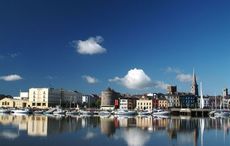Photo gallery: Click here
When Brian McAllister was coming of age in the 1950s all he cared about was playing basketball and chasing girls. However, over the years, he became the heart and soul of the business his Irish ancestors built and he fought hard to keep it from sinking out of the hands of future generations.
Today McAllister Towing and Transportation Co., Inc. is one of the nation’s largest towing companies with operations in ports all over the East Coast and Puerto Rico. Captain Brian McAllister, now 76, directs the action from his corner office at the tip of Manhattan overlooking the harbor where so much of his family’s history happened. Working with him are two sons and three nephews steering future generations along in the family trade.
The First Generation
The story began in 1864 when James McAllister left Cushendall, County Antrim, to come to New York, then the largest Irish city in the world. His brothers Daniel and William soon joined him. Along with many other Irish families, such as the Morans, they found their calling in the water traffic of New York Harbor. Indeed there were so many tug boats in New York Harbor, they were known collectively as the Irish Navy. James began with a single-sail lighter (a vessel that moves cargo between pier and ship) and called it Greenpoint Lighterage Company after the Brooklyn neighborhood where he had settled. Expanding into towing, McAllister’s first tug boat began operating in 1876 while the Brooklyn Bridge was being built.
James had four sons and six daughters in his first marriage and all the sons grew up working in the business, along with an assortment of cousins and other relatives. One day in 1899, his oldest son, James P. (known as Captain Jim) stormed out of Greenpoint Lighterage to go into business for himself around the corner from his father and uncles, but the family soon reunited to form McAllister Brothers and move to new offices at South Street along Manhattan’s East River waterfront. In 1909 they acquired the Starin fleet of excursion steamboats with regular runs to Coney Island, the Statue of Liberty and Bear Mountain. When James died in 1916 he left the towing and lighter business to his sons from his first marriage and the steamboat business to his two brothers. After James’s first wife died, he remarried and had three more children, though none of them became involved in the business.
Captain Jim, who was Brian’s grandfather, was always finding ways to promote the company and in 1914 offered the tug JP McAllister to Harry Houdini. The famous escape artist had himself handcuffed and sealed into a packing case and tossed into the harbor near the Battery. Miraculously, a few minutes later, he surfaced, free of the packing crate and his handcuffs.
Another story that has gone down in family lore is the visit of Eamon de Valera to New York. It began in 1922, when New York’s mayor Jimmy Walker called Captain Jim to see if he could pick up de Valera who had arrived by steamer in Hoboken to do some fund raising in Manhattan for the Irish cause. The captain sent his son Anthony, then 22, along to escort de Valera. More than 30 years later when Anthony and his wife passed by Parliament House on a visit to Dublin, he asked the guard to extend his compliments to the prime minister. To his astonishment, de Valera remembered him and asked McAllister and his wife to come around later for a visit.
During World War I, Captain Jim fitted out tugs for crossing the Atlantic during the war and was put in charge of the United States Army’s floating equipment. (During World War II, McAllister transported all the Army’s explosives through New York Harbor.) Captain Jim was described by one family member as the spark plug who kept the company expanding into new ventures. He lived to see the business triple in size and then get hit so hard by the Great Depression they were down to only one running tug. In 1935 Captain Jim died at 66. When Brian asked what caused his grandfather to die so young, his father told him he died of a broken heart.
Fortunately, all of the McAllisters had large families. Captain Jim had 10 children including three sons, Anthony J. (Brian’s father), James P. II, and Gerard, who, along with a few cousins, kept the business afloat. Although some daughters did work in the company offices from time to time, they were not given ownership. By the end of World War II, Brian’s dad and his two uncles had 35 tugs running, even though they were mostly worn out wooden steam tugs. They got through the Depression but at that time, Brian recalled, there was not enough work for everybody so only the smartest and hardest workers survived. The family built the company back up in the 40s and 50s and were operating 50 tugs in six ports. “After World War II, Moran had sealed up 70 percent of the ship business in the harbor. That was enormous,” Brian said. “McAllister had maybe 15 percent.” He said they were all highly competitive and engaged in price wars.
The Fourth Generation on the Brink
Brian was born on Christmas Day in 1932, one of eight children, and grew up in his grandfather’s house on Albemarle Road, near Prospect Park in Brooklyn. His father Anthony would take all the boys to the shipyard. “I was scared to death on the boats,” Brian said. When he was 12 or 13, and working as a summer deckhand on a tug, he recalls his fright watching the very tricky task of maneuvering one ship from a line of three and then moving another ship into the same slot. He told the pilot he was scared and was sent to the engine room. “I was happier down there,” he said, because he didn’t have to watch what was going on. Despite Brian’s alleged lack of interest in learning, he graduated from the State University of New York (SUNY) Maritime College at Fort Schuyler in 1956 with a bachelor’s degree in maritime engineering, but the family business was not calling him yet.
“The third generation had an agreement that only two sons from each branch of the family could work in the business, so I went into the Navy for two years.” He came out in 1958 as a Lieutenant JG and got a job with the American Express Isbrandtsen Line, making a lot of money. “I loved it,” he said, but by then also realized he was spending too much time away and asked his father for a job on the tugs. Anthony was able to get Brian a job as tug captain and eventually pilot. By the mid-1960s Brian had extensive seagoing experience and was promoted to the office.
Keeping It All in the Family
By the 1970s, Brian said his dad was not in good health and only three of the eight kids (Brian, Anthony, Jr., and Bruce) were in the business. “My uncles didn’t have all their kids in the business,” he added. (There are now close to one thousand descendants from the original James McAllister, but most of them drifted away from the family business into other areas. Those in the business today are descended from Captain Jim and his sons.)
Brian realized his father was getting close to selling the business for $20 million, part of which was stock in a Canadian company. “I was a fairly aggressive guy, although I didn’t know much about finance,” he admitted. Nevertheless, he convinced his brothers and cousins to put up $3,000 each and form a corporation to buy the company. “My father said, ‘You’ll never make it. You have no reserves to fall back on.’” It took four years to close the deal, but in 1974 the fourth generation bought the domestic company from the third generation for $15 million. Other pieces of the business went to various siblings and cousins. Brian invited a Harvard MBA to help with the financial arrangements and come aboard as a partner. The company expanded into the oil business. The outside partner wanted to sell the tug business, but Brian wanted to hold onto the company’s heritage. This resulted in a lawsuit for control and in 1998 the company was divided with the partner taking the oil business and Brian keeping the towing and ferry business. The settlement was made one day before the company was to be auctioned off. “My sons helped put a settlement together,” Brian said, “and the partner gave in.”
With Brian at the helm as owner and president of McAllister Towing, and five members of the fifth generation at work in the company, the family is keeping the business on track. Brian “Buckley” McAllister, 41, Brian’s oldest son, is vice president and general counsel. He is a graduate of the University of California’s Hastings College of Law. Eric, 39, graduated from New York University with a degree in economics and is the vice president, chief financial officer and treasurer. Their combined knowledge and expertise in finance and law helped Brian hang onto the business. Anthony J. (A.J.) McAllister III, 52, the son of Brian’s brother Anthony, Jr., is vice president of sales. He, like Brian, graduated from SUNY Maritime at Fort Schuyler and is a licensed tug master and docking pilot. Andrew McAllister, 36, is the son of Brian’s younger brother Michael. He has an MBA from New York University and is vice president. He also leads the company’s information technology department. Jeffrey McAllister, 53, son of Brian’s cousin James, is the company’s senior docking pilot in New York Harbor.
Although he doesn’t play basketball anymore, Brian is a vigorous man who plays golf and tennis whenever he can. He also likes to walk to work from the Manhattan apartment he shares with his wife of 42 years, the former Rosemary Owens, who taught math at the United Nations International School in New York. They met at a birthday party for Brian’s father. Rosemary was his younger brother’s date!
Today, nearly 150 years after James arrived from Cushendall, McAllister is still not as big as Moran Towing Company, but unlike Moran, the company is still in the family. Will the sixth generation carry on the family trade? It’s too soon to tell, but if it’s any incentive, they all have had tug- boats named for them.




Comments